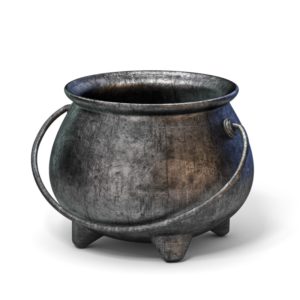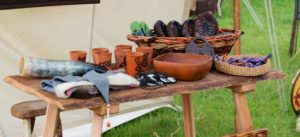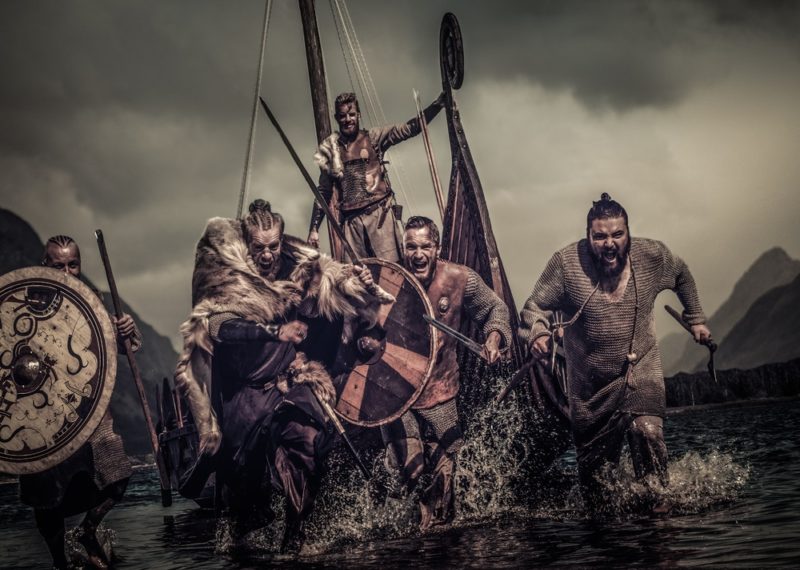In today’s world, we have fancy stainless steel cookware and electric fry pans to make our lives easier; however, Vikings didn’t have it that easy back in the day.
Unfortunately, there is insufficient evidence regarding what the Viking-age population ate and how their food was cooked. Archaeological research has discovered the raw ingredients and the cooking implements, but nothing is known about how the foods were prepared, combined, and served. Additionally, depending on the climate and the resources available, food presumably differed considerably among the Norse homelands.
What Did the Vikings Use to Cook?
Boiling food was the most popular way to cook during the Viking age. Sometimes, meat was cooked by being boiled in a pit lined with wood. They dug a trench and lined it with wood. Hot stones were thrown into the pit with the water and meat to heat it to boiling point. To keep the liquid hot, they would keep adding hot stones if necessary. Whatever herbs and spices might have been on hand were used to season the liquid.
In addition to being used for cooking, hot stones were also used for heating and drying.
The meat was also cooked on a spit. They often used a Norwegian spit with a complex handle that let you flip the meat while roasting it over the fire. While we cannot confirm, the spit most likely rested on fork sticks that were placed on either side of the fire.
More often, iron cauldrons or soapstone were used to boil food. Many tiny iron plates were heated together to form the cauldron. Cauldrons were often suspended over central firepits by hooks or iron chains that would hang from a house beam.
The standard proportions of an iron cauldron are stated in the medieval Icelandic lawbook Grágás: a weight of half a load (40 lbs) with a volume of eight bucketfuls (7.5 gallons). The required iron would have needed to be almost 1/4 inch thick. Cauldrons this big could not have been common; in the Viking Age, that much iron would have been a fortune. Cauldrons from the Viking age were often smaller than the average.
Additionally, food was roasted in soapstone pots. Although Viking territories were familiar with clay pottery, very few broken shards have been discovered, contrary to other regions of Europe. In Norse countries, pottery making was presumably a primitive art, and soapstone was the primary material. Clay pottery was used less frequently in some places, such as Iceland, where there was little clay that was appropriate for creating pottery.
The Vikings could easily pierce soapstone, which enabled it to be hung over the fire by iron hooks. In addition, unlike pottery, soapstone may be fixed using iron staples if cracked or broken.
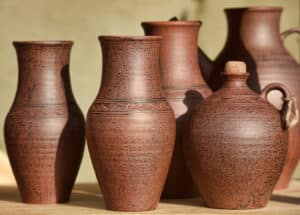
Liquids were first poured into a hanging animal hide before hot stones were placed inside when it needed to be heated.
Stone ovens were used in a few Norse homes. The interior of the oven was heated for cooking by rolling small stones that had been heated in an open cooking fire. In Viking-age house excavations, ovens were found with stones that had been repeatedly heated in the fire and cracked.
Over an open flame, fish or meat was cooked on the gridiron. The handle of the griddle rotates since the pan is attached to it with one rivet. It was once believed that doing this enabled the pan to be turned inside the fire, facilitating equal cooking. The idea that a revolving pan promotes even cooking has been somewhat refuted by discoveries in which pans were fastened to handles with two rivets, which prevents rotation.
Materials Used by the Vikings
Pottery
The majority of Viking-era pottery was plain and dedicated to eating, cooking, and storing sharp utensils. Most domestic pottery was produced locally; however, there is evidence that finer goods were exported from the Rhineland to the Nordic nations.
Layers of tempered clay were built up, molded, and smoothed to create the pottery (coiling). Craftspeople began using kick wheels or turning tables later in the Viking era.
Instead of using a complex kiln, the pottery was placed in a pit with a fire on top. The pottery turned black or grayish as a result of the pit’s lack of oxygen throughout this process.
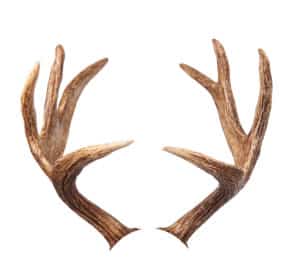
Bone
In the Viking age, rural and more developed places had easy access to antler and bone, not the least of which was food production waste.
Craftsmen created a variety of helpful and frequently attractive Viking pots using various animal and skeleton components. Bone and antler were used to make needles, and as bird bones are inherently hollow, they were used to make needle cases. The front leg of a sheep could be used to create flutes.
In addition to being helpful, fresh bone and antler are pliable enough to allow the craftsman to embellish the item by drilling, filing, cutting, and scraping.
Soapstone
The Vikings did not produce a lot of pottery; however, they employed natural materials such as horn and bone for cups, as well as wood for plates. Their cooking utensils and comparable items were made of soapstone.
Soapstone was used to make cooking pots and later baking plates because, as the name suggests, it’s soft and easy to work with while fresh but hardens when exposed to heat. Soapstone was also used to make smaller items such as lamps, spindle whorls, looms, and fishing weights.
The Vikings chiseled the necessary shape into the rock on the hillside in order to quarry the stone, resulting in the creation of round and rectangular blocks. They worked the hillside in stages such that one side was always exposed, typically as a result of earlier workings.
They pried the block off by driving wedges under the base after chiseling the outline to the necessary depth. (Modern trials with this method have revealed that with practice, it takes around an hour.) The blocks occasionally fractured, especially along the oxidation lines. The Vikings frequently attempted to rectify the situation by cutting the block into a smaller object (perhaps a loom weight or lamp).
On the hillside, the fundamental shape of the Viking cookware was created, both internally and externally. This was probably done to make the blocks easier to transport and to prevent breakages from occurring when they were being moved.
Smaller products were then produced away from the quarries, including bake plates and finished bowls. When the item was finished being created, the surface could be polished with pumice to get a nice finish and give it a lovely appearance. While this isn’t as luxurious as your cookware sets with aluminum exterior finishes, this was quite impressive.
Different Types of Viking Cookware
Dish Iron
This is essentially the ‘fry pan’ of the Viking era. Flatbread batter and eggs would have been cooked in this flat cookware along with other more liquid items. All of the period samples have slightly upward-curving edges. Most relics just have one rivet connecting the handle to the dish.
Spiral Cooking Iron
This cooking utensil is perfect for grilling meats. Furthermore, the discovery of one of the relics among other cooking implements led researchers to the opinion that this device was initially used to cook meat.
Hook and Chain Trammel
This item can be used exactly as is, straight on top of a metal tripod. When camping in the Viking Age, a length of rope would be fastened to one end and used to secure the trammel to a house beam or wooden pole tripod.
Meat Fork
In place of a spit, a meat fork was used for roasting larger pieces of meat. When in use, a forked stick that was positioned adjacent to the fire would be used to raise the fork. The shaft’s free end would be supported by a rock and would rest on the ground.
Mastermyr Pot
These original pots were constructed of “copper alloy,” which is a material halfway between brass and bronze. These copper alloy pots are thought by some experts to be status insignia that are used to cook mead or wine. The top edge of the pot was folded over for strength.
Viking Age Tablewear
Tableware from the Viking Age comprised mostly of wooden bowls, plates, and mugs. Iron knives, ladles, and wooden spoons were used during cooking. They also employed more improvised tools, such as fragments of shattered clay jars. These were used for moving around heated stones and embers as well as for scooping up food.
The hearth was crucial to cooking. This could be an open hearth or smoke oven, which is typically positioned in the middle of the room. Clay pots were used to cook the majority of the food. Next to the hearth, there was occasionally an ash pit.
Cooking stones were also used for making boiling water or soup. These were fist-sized boulders that were heated on the hearth at high temperatures and then used to boil water and soup in cooking pots. After a few uses, cooking stones become brittle and had to be thrown away. Hence, they are commonly found in archaeological findings.
How Many Meals Did Vikings Eat a Day?
Viking families ate about two meals a day: one at mid-morning and one in the evening. The majority of households had some kind of table, and linen tablecloths were utilized by rich households. Meat was served on a wooden trencher, and each person used their own knife to cut them. Wooden bowls were used to serve porridge, stews, and other similar foods, while horn or wooden spoons were used to eat them. Spatulas and ladles were made from shells.
Drinking horns or wooden cups were used to hold cold liquids (particularly for feasts). The Vikings also used silver or copper-colored metal cups. Although it is known that drinking glasses were formerly in use, only the wealthiest families could afford them.
Viking Food
Depending on the area, Viking cuisine varied, but the majority of it was cooked in soapstone, clay, or iron pots.
Vikings lacked forks; however, they did have spoons, knives, and fingers. To make food easier to eat, it was typically sliced up before it was cooked. Additionally, meat that had been salted or dried required a vigorous boiling to rehydrate it before eating.
Of course, a lot of Vikings relied heavily on fish. The stockfish was dried cod, which is quite hard and dry. Stockfish had to be beaten with the ax’s backside in order to prepare it.
The leathery cod was a staple food during the Viking Age, but they did not make or consume lutefisk.
It appears that the Vikings did not hunt or gather anything other than dried fish. Domestic cattle, goats, and sheep are the main sources of bones discovered in archeological sites. The majority of the vegetables and grains consumed by Vikings were also grown.
From the grain, they produced bread and, more significantly, beer. Beer was a standard mealtime beverage. It provided some essential nutrients and had health benefits, including preventing waterborne infections.
The majority of beer was made in open vats without hops. Rather, Vikings used flavor-enhancing herbs such as bog myrtle.
The largest variety of commodities was accessible during Autumn. It was also a time when imported commodities were most widely available, as well as newly butchered meat, grains, and fresh vegetables. To make the most of this variety, feasts and festivals were scheduled for the autumn. Small game, fish, nuts, vegetables, and fruit are among the several foods that were accessible in York throughout the Viking era.
Nothing suggests that subpar cuisine or cooking techniques were common throughout the Norse age. Contrary to popular belief, the Vikings did have spices and utilized them to improve the flavor of food rather than to cover up the taste of food gone bad. According to what is known today, it is very likely that a diverse and healthy diet was available. However, there is not enough information to determine whether the entire Viking population was able to benefit from such a diet.
FAQs
Did the Vikings Add Any Conduction and Induction Materials to Their Cookware?
No, they did not. While most pots and pans today either have an aluminum alloy core or copper core, the Vikings solely used soapstone or clay for their cookware. Remember that during the Viking age, metals were not easily accessible.
What Were Viking Plates and Bowls Made Out of?
The plates and bowls used by the Vikings were fairly similar to ours, but they were frequently made of wood rather than pottery. They used a knife that was both a knife and a fork while eating. Horn, wood, or animal bone were used to make spoons.
How Did the Vikings Make Bread?
Unleavened barley flour was traditionally ground in stone querns to make bread. Grain was ground between the stones by rotating the top stone over the bottom stone with the help of the quern’s handle. Lava querns were used in Iceland to create finer flour. The bread must have had a grittier meal because stone shards from querns have been discovered in recovered flour.
Conclusion
You’re probably feeling extremely grateful for your stainless steel cookware, stove, and dishwasher right now, aren’t you? While the Vikings did not have a wide variety of fancy cookware, they did have sufficient fry pans and iron pots that could take high heat. If you ever find yourself without your favorite saucepans, remember that the Vikings didn’t need fancy pots to make delicious food. There are various replicas available for sale to this day if you ever want to try your hand at cooking the way the Vikings did.


